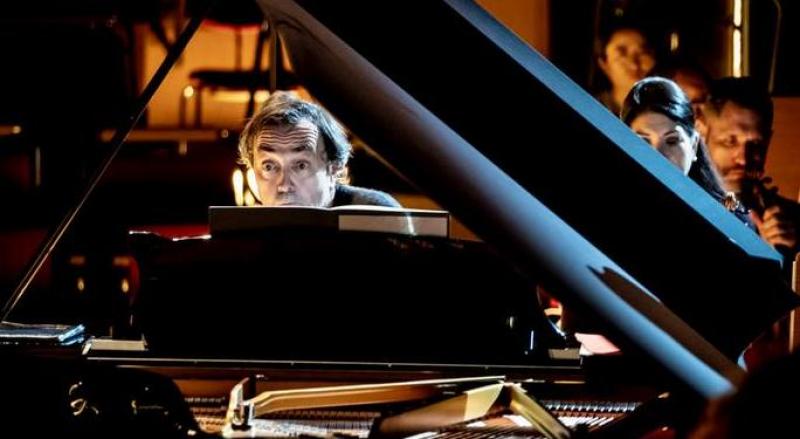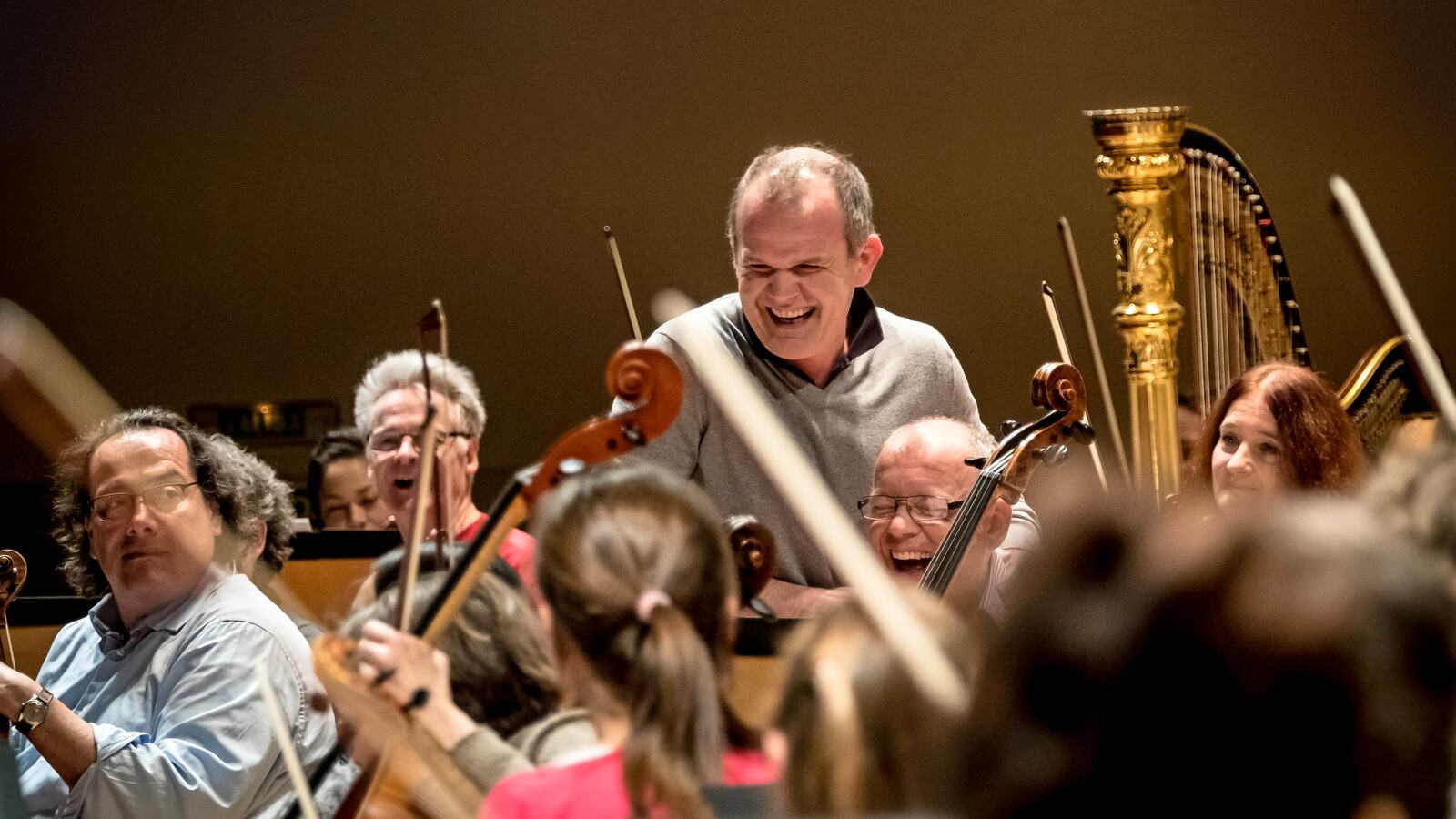Aimard, Gürzenich-Orchester Köln, Roth, RFH review - Beethoven as avant-gardist | reviews, news & interviews
Aimard, Gürzenich-Orchester Köln, Roth, RFH review - Beethoven as avant-gardist
Aimard, Gürzenich-Orchester Köln, Roth, RFH review - Beethoven as avant-gardist
Only connect: works up to two centuries apart meet and argue in vital programming

In Beethoven anniversary year, there are three ways to enhance our ongoing concert dialogues with the composer beyond the bog-standard overture-concerto-symphony format: complete cycles of the quartets, symphonies and sonatas, preferably without old vulgarians presenting; focusing on Beethoven and his contemporaries, including programmes recreated from the early 1800s; and linking the genius with what our
By making its own unique tribute to the whopping "academies" the composer presented, not least in the 1808 blockbuster which included the premieres of the Fifth and Sixth Symphonies, interlacing the familiar with the shock of the new and placing a charismatic pianist at the centre, as happened with Beethoven himself, this very singular visit from the iconoclastic François-Xavier Roth and Cologne's oldest orchestra - its Philharmonie is also fortunate to play host to the NDR Symphony Orchestra - ticked the second and third boxes with aplomb.
 Not quite as long as the 1808 extravaganza, this was still a pack-everything-in event, sometimes challenging to the point of perversity. Not so the first half, where the Fifth, “Emperor” Concerto was flanked by the air and humour it lacks. Roth had brought in a choreographer, Jörg Weinöhl, to make the players “act”, and an award-winning German composer, Isabel Mundry (pictured right), to provide a soundscape, around Pierre-Laurent Aimard’s selection of four tiny Bagatelles from 1920. The aftermath, Roth holding down the last chord of the concerto with a slight fade for a silent segue, was a hoot: Francesco Filidei’s Quasi una bagatella, a comic battleground for pianist and orchestra to jab or propose to each other before rushing into helter-skelter combat with the inevitable “Emperor” quotation melted into the mix. Like so many musical jokes, it was slightly over-extended, but brilliantly executed.
Not quite as long as the 1808 extravaganza, this was still a pack-everything-in event, sometimes challenging to the point of perversity. Not so the first half, where the Fifth, “Emperor” Concerto was flanked by the air and humour it lacks. Roth had brought in a choreographer, Jörg Weinöhl, to make the players “act”, and an award-winning German composer, Isabel Mundry (pictured right), to provide a soundscape, around Pierre-Laurent Aimard’s selection of four tiny Bagatelles from 1920. The aftermath, Roth holding down the last chord of the concerto with a slight fade for a silent segue, was a hoot: Francesco Filidei’s Quasi una bagatella, a comic battleground for pianist and orchestra to jab or propose to each other before rushing into helter-skelter combat with the inevitable “Emperor” quotation melted into the mix. Like so many musical jokes, it was slightly over-extended, but brilliantly executed.
Aimard is always fascinating in his hyper-nuanced articulation, which goes a long way to offset what for me is a less than interesting piano sound; no-one wanted grandeur in the concerto, but a high sheen would have been good. The real novelties came in the orchestra, especially in the violas’ inititally ghostly little turn crescendoing into the first-movement recap. None of this solved my personal blind-spot with this work and especially its over-long finale, along with the Third Piano Concerto and the second and fourth movements of the Fifth Symphony; but I’m not alone – Glenn Gould also had a problem with middle-period Beethoven.
Part Two was more wayward and bolder with lighting – moonlight for That Sonata Movement, again offset by Mundryana, and a suggestion of the Yves Klein ultramine which inspired Zimmermann’s ever-astounding Photoptosis. The path to that was long and curious. The “Moonlight” faded into the somehow coherent jabs and chord-colours of Lachenmann’s Tableau. Paul Griffiths' observation in the programme - "Lachenmann paints with sounds, has them act and resist" - seemed at first uncharacteritically loose: doesn't every composer?. But if you thought about it, no, not every composer succeeds, and Beethoven was supreme in that; again, only connect. Tableau in turn resonated with the opening chordal try-outs of Beethoven’s First Symphony. Of which we got, bizarrely, only the first-movement exposition, albeit repeated, with plenty of gutty bite from the strings but not quite the fine-tuning of the performance from Nicholas Collon and the Aurora Orchestra the other weekend.  Plunging from C to its relative minor with the Allegretto of the Seventh Symphony, Roth (pictured above with some of his players) legatoed the later woodwind phrases to set up the Arietta (back to C) of the Op. 111 sonata; again, I’d have liked a bit more heavenly shine to Aimard’s sound, but his phrasing was, as before, keen and individual. We never got to the end; a trill melted into the start of Photoptosis. Its sonic frenzies felt especially ambivalent in the light of the recent German horror, the twilight of quotations (a collapse initiated by Beethoven’s Ninth-Symphony angry gesture of dismissal to spotlight Scriabin) fumbling for meaning before the final, virtuosic apocalypse, The Rite of Spring on, rather than in, ecstasy.
Plunging from C to its relative minor with the Allegretto of the Seventh Symphony, Roth (pictured above with some of his players) legatoed the later woodwind phrases to set up the Arietta (back to C) of the Op. 111 sonata; again, I’d have liked a bit more heavenly shine to Aimard’s sound, but his phrasing was, as before, keen and individual. We never got to the end; a trill melted into the start of Photoptosis. Its sonic frenzies felt especially ambivalent in the light of the recent German horror, the twilight of quotations (a collapse initiated by Beethoven’s Ninth-Symphony angry gesture of dismissal to spotlight Scriabin) fumbling for meaning before the final, virtuosic apocalypse, The Rite of Spring on, rather than in, ecstasy.
Interesting that Zimmermann subtitlted the work “Prélude”; it was so refreshing, alongside everything else in this astonishing evening, that Photoptosis moved from the usual “parking-lot” spot at the beginning of the programme to the end. So much to go away and think about, but also quite enough to feel in the moment. The wild enthusiasm at the end came from an ideally mixed audience; the Southbank is clearly doing something right in bringing new listeners to an experience which is so much more than just "classical". And please note the European/international credentials: French pianist and conductor working with an orchestra of all nations, German only strictly in name, including a British principal oboist (Tom Owen), and on German and Italian works. The free movement so conspicuous on every level in this happening must continue.
rating
Share this article
The future of Arts Journalism
You can stop theartsdesk.com closing!
We urgently need financing to survive. Our fundraising drive has thus far raised £49,000 but we need to reach £100,000 or we will be forced to close. Please contribute here: https://gofund.me/c3f6033d
And if you can forward this information to anyone who might assist, we’d be grateful.

Subscribe to theartsdesk.com
Thank you for continuing to read our work on theartsdesk.com. For unlimited access to every article in its entirety, including our archive of more than 15,000 pieces, we're asking for £5 per month or £40 per year. We feel it's a very good deal, and hope you do too.
To take a subscription now simply click here.
And if you're looking for that extra gift for a friend or family member, why not treat them to a theartsdesk.com gift subscription?
more Classical music
 From Historical to Hip-Hop, Classically Black Music Festival, Kings Place review - a cluster of impressive stars for the future
From quasi-Mozartian elegance to the gritty humour of a kitchen inspection
From Historical to Hip-Hop, Classically Black Music Festival, Kings Place review - a cluster of impressive stars for the future
From quasi-Mozartian elegance to the gritty humour of a kitchen inspection
 Shibe, LSO, Adès, Barbican review - gaudy and glorious new music alongside serene Sibelius
Adès’s passion makes persuasive case for the music he loves, both new and old
Shibe, LSO, Adès, Barbican review - gaudy and glorious new music alongside serene Sibelius
Adès’s passion makes persuasive case for the music he loves, both new and old
 Anja Mittermüller, Richard Fu, Wigmore Hall review - a glorious hall debut
The Austrian mezzo shines - at the age of 22
Anja Mittermüller, Richard Fu, Wigmore Hall review - a glorious hall debut
The Austrian mezzo shines - at the age of 22
 First Person: clarinettist Oliver Pashley on the new horizons of The Hermes Experiment's latest album
Compositions by members of this unusual quartet feature for the first time
First Person: clarinettist Oliver Pashley on the new horizons of The Hermes Experiment's latest album
Compositions by members of this unusual quartet feature for the first time
 Gesualdo Passione, Les Arts Florissants, Amala Dior Company, Barbican review - inspired collaboration excavates the music's humanity
At times it was like watching an anarchic religious procession
Gesualdo Passione, Les Arts Florissants, Amala Dior Company, Barbican review - inspired collaboration excavates the music's humanity
At times it was like watching an anarchic religious procession
 Classical CDs: Camels, concrete and cabaret
An influential American composer's 90th birthday box, plus British piano concertos and a father-and-son duo
Classical CDs: Camels, concrete and cabaret
An influential American composer's 90th birthday box, plus British piano concertos and a father-and-son duo
 Cockerham, Manchester Camerata, Sheen, Martin Harris Centre, Manchester review - re-enacting the dawn of modernism
Two UK premieres added to three miniatures from a seminal event of January 1914
Cockerham, Manchester Camerata, Sheen, Martin Harris Centre, Manchester review - re-enacting the dawn of modernism
Two UK premieres added to three miniatures from a seminal event of January 1914
 Kempf, Brno Philharmonic, Davies, Bridgewater Hall, Manchester review - European tradition meets American jazz
Bouncing Czechs enjoy their Gershwin and Brubeck alongside Janáček and Dvořák
Kempf, Brno Philharmonic, Davies, Bridgewater Hall, Manchester review - European tradition meets American jazz
Bouncing Czechs enjoy their Gershwin and Brubeck alongside Janáček and Dvořák
 Solomon, OAE, Butt, QEH review - daft Biblical whitewashing with great choruses
Even a top soprano and mezzo can’t make this Handel paean wholly convincing
Solomon, OAE, Butt, QEH review - daft Biblical whitewashing with great choruses
Even a top soprano and mezzo can’t make this Handel paean wholly convincing
 Two-Piano Gala, Kings Place review - shining constellations
London Piano Festival curators and illustrious friends entertain and enlighten
Two-Piano Gala, Kings Place review - shining constellations
London Piano Festival curators and illustrious friends entertain and enlighten
 Echo Vocal Ensemble, Latto, Union Chapel review - eclectic choral programme garlanded with dance
Beautiful singing at the heart of an imaginative and stylistically varied concert
Echo Vocal Ensemble, Latto, Union Chapel review - eclectic choral programme garlanded with dance
Beautiful singing at the heart of an imaginative and stylistically varied concert
 Scott, Irish Baroque Orchestra, Whelan, RIAM, Dublin review - towards a Mozart masterpiece
Characteristic joy and enlightenment from this team, but a valveless horn brings problems
Scott, Irish Baroque Orchestra, Whelan, RIAM, Dublin review - towards a Mozart masterpiece
Characteristic joy and enlightenment from this team, but a valveless horn brings problems

Add comment